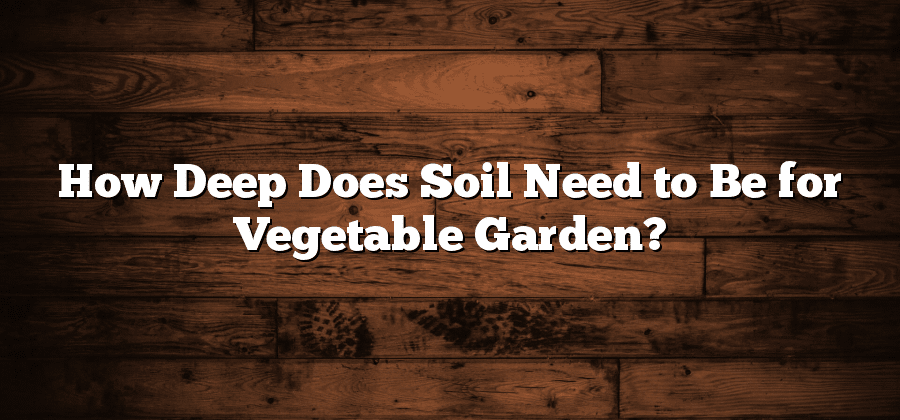Ideal soil depth for vegetable gardening
Vegetable gardening can be a rewarding and fruitful endeavor, but it requires careful consideration of soil depth. The ideal soil depth for vegetable gardening is generally around 8 to 12 inches. This depth provides ample space for root development and ensures that plants have access to necessary nutrients and water.
When choosing the ideal soil depth for your vegetable garden, it is important to consider the requirements of the specific vegetables you wish to grow. Different vegetables have varying root depths, and tailoring the soil depth accordingly will help promote healthy and vigorous growth. For instance, shallow-rooted vegetables like lettuce and radishes can thrive in shallower soil depths, while deep-rooted vegetables like tomatoes and carrots require deeper soil to spread their roots and extract water and nutrients effectively. Understanding the root depth requirements of different vegetables will help you make informed decisions about the optimal soil depth for your garden.
Factors to consider for soil depth
One important factor to consider when determining soil depth for vegetable gardening is the type of vegetable being grown. Different vegetables have varying root depth requirements, which will ultimately dictate the ideal soil depth needed for their growth. For example, shallow-rooted vegetables such as lettuce and radishes can thrive in soil depths as shallow as six inches, while deep-rooted vegetables like tomatoes and carrots typically require a soil depth of at least 12 inches or more. Therefore, it is crucial to research the specific root depth requirements of the vegetables you plan to grow in order to determine the appropriate soil depth for your garden.
Another factor to take into account is the available space for gardening. If you have limited space in your garden or are gardening in containers, you may need to compromise on soil depth. In such cases, choosing vegetables that have shallower root systems or opting for compact varieties can be a smart approach. Additionally, it is worth considering the overall structure and composition of the soil in your garden. Certain soil types, such as loam or sandy soil, may naturally have better drainage, allowing for shallower soil depths. Conversely, clay soils with poor drainage may require deeper soil depths to ensure proper root development. Evaluating these factors will help you make informed decisions when determining the ideal soil depth for your vegetable garden.
Understanding root depth requirements
The depth of soil plays a crucial role in the overall health and productivity of vegetables. Understanding the root depth requirements of different vegetable plants is essential for successful gardening. Root depth refers to the length that a plant’s roots need to penetrate into the soil to access nutrients and water effectively.
Various vegetable plants have different root depth requirements. Some plants, such as lettuce and spinach, have shallow roots that only need to go down a few inches into the soil. On the other hand, crops like tomatoes and peppers require deeper soil, as their roots can extend several feet underground. Knowing the specific root depth requirements of each vegetable plant will allow you to provide the ideal conditions for their growth and development.
It is important to note that insufficient soil depth can lead to stunted growth, limited nutrient uptake, and water stress for vegetable plants. On the contrary, deeper soil provides a larger reservoir for water and nutrients, allowing the roots to spread out and access resources more efficiently. By understanding the root depth requirements of your chosen vegetable plants, you can ensure that they have enough space to grow and thrive, resulting in healthier and more productive crops.
Choosing the right vegetables for shallow soil
When it comes to gardening in shallow soil, choosing the right vegetables is crucial for success. Vegetables that have shallow root systems are more likely to thrive in this type of soil, as they can access nutrients and water more easily. One example of a vegetable that does well in shallow soil is lettuce. Lettuce has a shallow root system, making it able to tolerate limited soil depth. Additionally, leafy greens like spinach and kale are also good choices for shallow soil, as they have relatively shallow root systems and can still produce abundant foliage.
Another option to consider for shallow soil is root vegetables that have shorter growing seasons. Radishes, for instance, are an excellent choice as they can grow in as little as 6-8 inches of soil. Carrots are another option, as they have a relatively shallow root system. However, it is essential to choose shorter varieties of carrots that are specifically bred for shallow soil to ensure optimal growth. By selecting vegetables that can adapt to shallow soil conditions, gardeners can still enjoy a bountiful harvest even with limited soil depth.
• Lettuce is a great choice for shallow soil due to its shallow root system.
• Leafy greens like spinach and kale can thrive in shallow soil and produce abundant foliage.
• Radishes are an excellent option as they can grow in as little as 6-8 inches of soil.
• Carrots with shorter varieties specifically bred for shallow soil are also suitable for limited depth conditions.
Benefits of deeper soil for vegetable growth
Deep soil can play a pivotal role in promoting optimal vegetable growth. The ample depth of soil allows for ample root development, enabling plants to access a greater amount of nutrients and water. In turn, this promotes healthier and more vigorous growth, leading to higher yields and better overall crop quality. Additionally, deeper soil provides improved drainage, preventing excess water from accumulating around the roots and reducing the risk of root rot and other related diseases. This benefit is particularly valuable in areas with heavy rainfall or in regions where irrigation is necessary. The improved access to nutrients and water, combined with excellent drainage, makes deeper soil a valuable asset for vegetable gardeners looking to maximize their harvests.






